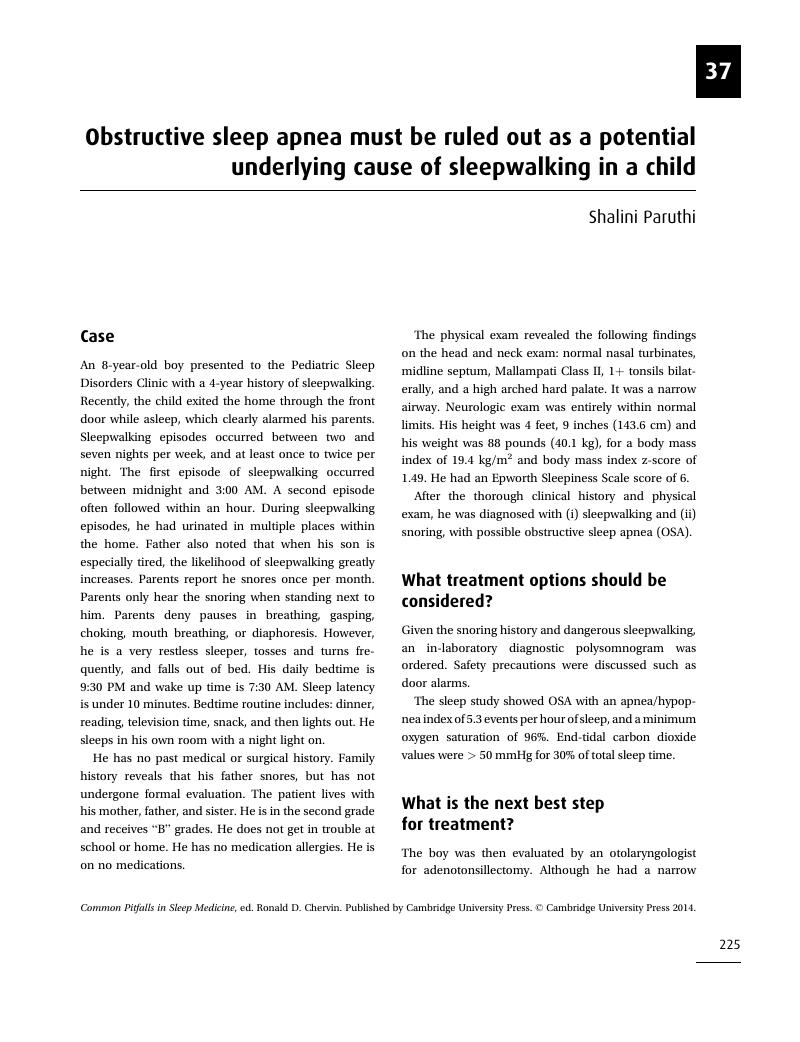Book contents
- Common Pitfalls in Sleep Medicine
- Common Pitfalls in Sleep Medicine
- Copyright page
- Contents
- Contributors
- Preface
- Acknowledgements
- 1 Introduction: the complexity, challenges, and rewards of effective sleep medicine
- Section one Sleepiness versus fatigue, tiredness, and lack of energy
- Section two Assessment of daytime sleepiness
- Section three Diagnosis of narcolepsy
- Section Four Diagnosis of obstructive sleep apnea
- Section Five Positive airway pressure to treat obstructive sleep apnea
- Section Six Alternatives to positive airway pressure in the treatment of obstructive sleep apnea
- Section Seven Diagnosis and treatment of chronic insomnia
- Section Eight Restless legs syndrome and periodic leg movements
- Section Nine Parasomnias
- 34 Diagnosis of a non-REM parasomnia without consideration of a patient’s psychological makeup and its possible contribution can leave key issues unaddressed
- 35 History and polysomnographic findings are both critical to distinguish different parasomnias
- 36 Diagnosis and counseling for rapid eye movement sleep behavior disorder: a potential window into an uncertain neurologic future
- 37 Obstructive sleep apnea must be ruled out as a potential underlying cause of sleepwalking in a child
- 38 An adult parasomnia can sometimes reflect effects of occult obstructive sleep apnea
- Section Ten Circadian rhythm sleep disorders
- Section Eleven Missed diagnoses of obstructive sleep apnea can exacerbate medical and neurologic conditions
- Section Twelve Sleep in children
- Section Thirteen Sleep in older persons
- Index
37 - Obstructive sleep apnea must be ruled out as a potential underlying cause of sleepwalking in a child
from Section Nine - Parasomnias
Published online by Cambridge University Press: 05 April 2014
- Common Pitfalls in Sleep Medicine
- Common Pitfalls in Sleep Medicine
- Copyright page
- Contents
- Contributors
- Preface
- Acknowledgements
- 1 Introduction: the complexity, challenges, and rewards of effective sleep medicine
- Section one Sleepiness versus fatigue, tiredness, and lack of energy
- Section two Assessment of daytime sleepiness
- Section three Diagnosis of narcolepsy
- Section Four Diagnosis of obstructive sleep apnea
- Section Five Positive airway pressure to treat obstructive sleep apnea
- Section Six Alternatives to positive airway pressure in the treatment of obstructive sleep apnea
- Section Seven Diagnosis and treatment of chronic insomnia
- Section Eight Restless legs syndrome and periodic leg movements
- Section Nine Parasomnias
- 34 Diagnosis of a non-REM parasomnia without consideration of a patient’s psychological makeup and its possible contribution can leave key issues unaddressed
- 35 History and polysomnographic findings are both critical to distinguish different parasomnias
- 36 Diagnosis and counseling for rapid eye movement sleep behavior disorder: a potential window into an uncertain neurologic future
- 37 Obstructive sleep apnea must be ruled out as a potential underlying cause of sleepwalking in a child
- 38 An adult parasomnia can sometimes reflect effects of occult obstructive sleep apnea
- Section Ten Circadian rhythm sleep disorders
- Section Eleven Missed diagnoses of obstructive sleep apnea can exacerbate medical and neurologic conditions
- Section Twelve Sleep in children
- Section Thirteen Sleep in older persons
- Index
Summary

- Type
- Chapter
- Information
- Common Pitfalls in Sleep MedicineCase-Based Learning, pp. 225 - 228Publisher: Cambridge University PressPrint publication year: 2014

